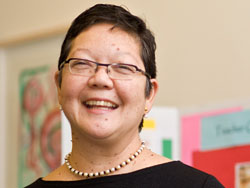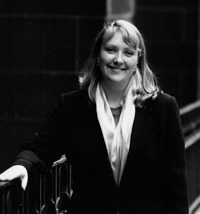Winter Reading: Books by TC Faculty
Winter Reading: Books by TC Faculty
Injustice Writ Small
By Siddhartha Mitter
The reminder that the United States has the highest rates of child poverty among 19 industrialized countries comes early in Promoting Social Justice for Young Children (Springer, 2011), co-edited by Beatrice S. Fennimore, professor of education at Indiana University of Pennsylvania, and A. Lin Goodwin, education professor and Vice Dean at TC. Between poverty, health care and a public failure to safeguard their rights, “children have become the most vulnerable subgroup in the United States,” writes contributor Valerie Polakow.
The book’s 14 chapters cover a broad scope. Sections on empowering parents and communities and developing education methods that incorporate a social justice commitment are balanced by chapters on specific issues such as the sexualization of childhood, or the impact of the past decade’s long overseas wars on America’s children. A cluster of chapters addresses issues in the education of immigrant children—from dealing with the reality of families where some members are undocumented, but not others, to the problems with the pervasive habit (sometimes initiated by the parents themselves) of Americanizing the names of children to make them appear less “alien.”
Still another thread deals with how to prepare teachers to recognize and advance social justice concerns. A chapter on teacher preparation by TC faculty member Celia Oyler discusses, for instance, the ways teachers of young children can shift from “deficit constructions” of what children lack to “capacity constructions” of what children can do. Contributors Beth A. Ferri and Jessica Bacon present the value of disability studies in preparing teachers to identify and overcome “ableism” in their practices.
All the writings in the book are linked by the axiom that children have rights, but in the United States those rights are all too often unfulfilled. The editors point out the country is one of only three members of the United Nations not to have ratified the Convention on the Rights of the Child (CRC), which came into force in 1990. (The other two are Somalia and South Sudan.) The burden of advancing children’s rights thus falls on caregivers and educators in the classroom and community. “[We] have a lot we must do before every child in our rich and resource-full country can be entitled to a basic level of care and social support,” writes Goodwin in the conclusion. This volume shows some of the ways forward.
The Language of School Success
By Siddhartha Mitter
Lesley Bartlett and Ofelia García were conducting research on the educational trajectories of Latino students when they spotted an intriguing anomaly in at a high school in Washington Heights, in upper Manhattan.
Bartlett, Associate Professor in TC’s department of International and Transcultural Studies, and García, a former TC faculty member who is now a professor of urban education at CUNY’s Graduate Center, were looking at national high school completion rates, which a 2001 study estimated at just 63 percent for Latinos. New York City’s rate was even lower: between 50 and 60 percent. Amid this picture, Gregorio Luperón High School stood out, graduating 70 to 80 percent of its students. Not only that: the Luperón students were mostly ‘newcomers’ -- recent arrivals from the Dominican Republic and elsewhere, whose schooling in their own countries typically had been interrupted.
“We wondered, ‘What is it that this school does with newcomers?’” Barlett says. “‘What do they do to get them through?’ That was the puzzle that motivated our inquiry.”
So began a four-year study in which Bartlett and García immersed themselves in the Luperón community, observing classes and interviewing students, teachers, administrators and family members to develop a full panorama of the school and its success at bucking a dismal trend.
Their findings are presented in Additive Schooling in Subtractive Times: Bilingual Education and Dominican Immigrant Youth in the Heights (Vanderbilt University Press, 2011). The book is simultaneously the story of how the school, founded in 1994, has negotiated New York City and state education policy; an anthropology of the Luperón school community; and a contribution to scholarship on bilingual education at a time when bilingual programs are more often cut than created.
Luperón itself is not merely a bilingual school; rather, it practices what Bartlett and García call “translanguaging”—an adaptive method by which teachers and students work in two languages as necessary, developing skills and functioning in both. Students prepare for Regents exams in both English and Spanish.
“It takes savvy and committed educators to figure out how to set up and protect those models—not only the institutions, but the pedagogical and curricular choices -- at a time when there’s increasing emphasis on very narrow measures of teacher quality and student learning, Regents and other standard tests,” Bartlett says.
The Luperón team clearly meets those criteria. The school’s co-founders were rooted in the Heights community and its faculty and staff share what Bartlett calls “a cultural, social and political commitment to not only the students but their families.” And while life at the school has grown from a two-year “newcomer school” to a four-year high school with more non-newcomer youth and all the pressures of standardized testing and assessment -- a veteran core group, known as “los pioneros,” have kept things anchored. “They socialize new faculty and staff into that shared vision,” Bartlett says.
Yet as successful as Luperón has been, it is just one school, and, as a chapter in Additive Schooling documents through interviews, its graduates emerge into a work and higher-education landscape in which low-income Latino immigrants face many obstacles.
“The school piece is the first piece but it alone is not enough,” Bartlett says. “We have to figure out the school-to-work transitional model, as well as school-to-further schooling, to meet the needs of this specific population.”
Bartlett and García believe Luperón’s success in educating immigrant youth can be replicated, and in their concluding chapter they list key ingredients for doing so. Among these are community involvement, highly motivated staff, a school culture of engagement, and “additive” schooling that builds social capital among and between students and teachers in numerous ways.
All of those attributes combine to produce what Bartlett says may be Luperón’s ultimate strength: “This was a strikingly different school culture. The students had a really strong sense of belonging to the school.”
From Russia, with Love... for Mathematics
By Siddhartha Mitter
In Russia, a country famed for its contributions to mathematics and its high standard of math teaching, the walls of math classrooms are often adorned with the portraits of famous mathematicians.
It’s no accident that some of those same faces can be found in pictures hanging in the Thompson Hall office of TC’s Math, Science and Technology Program.
During the Khrushchev era in the early 1960s, Bruce Vogeli, now TC’s Clifford Brewster Upton Professor of Mathematical Education and Director of the College’s Program in Mathematics eEducation, spent half a year teaching in Moscow and has maintained close ties with Russia ever since. By the mid-1990s, when Vogeli visited St. Petersburg, Alexander Karp was already a well-regarded math education specialist there. Karp came to TC as a visiting professor in1998 and is now Associate Professor of Mathematics and Education.
Now Vogeli and Karp have produced Russian Mathematics Education, a landmark collection offering a wealth of detail on how Russian math education evolved from Czarist times through today, how it has weathered the country’s political and social changes, and how teachers are trained and all aspects of mathematics taught in Russian schools.
With writings by 24 contributors from Russia, the United States, Poland, Cuba, Hungary and Israel spread across two volumes -- “History and World Significance” and “Programs and Practices” – Russian Mathematics Education has an encyclopedic heft and feel.
Several chapters trace the history of reforms and counter-reforms in Russian math education over the decades. The special role of high-level academic mathematicians in curriculum development, the tradition of school contests and Olympiads, and the influence of Russian methods on other countries are discussed in detail. So are the specifics of teaching algebra, geometry and calculus, as well as of teacher training, assessment and education research.
In part, the editors say in their introduction, the project responds to the flood of highly-trained Russian mathematicians who have moved to the West since the Gorbachev period, and to curiosity about the system that has produced such talent. But more broadly, the book is a lens onto a culture in which a positive attitude toward mathematics is a signature point of pride.
In the United States “you hear a lot of negative stories about mathematics,” Karp says. “People say, ‘Oh, I don’t understand mathematics,’ or ‘I hated math’ or ‘I was afraid of mathematics.’ In Russia, for many reasons, the general attitude is very different.”
Those reasons include “a tradition of long and serious treatment of objects and a culture of reasoning and discussion and exploring of these objects,” Karp says. Russian schools emphasize “intensive lessons in which the teacher organizes activities in a meaningful sequence, which gives students an opportunity to really think about the subject on their own level.
“It’s a fantastic thing when you can see that students are not necessarily mathematical geniuses, but are actively thinking mathematically,” he says. “It’s really mathematics for all.”
Then, too, Russian math teachers typically have more mathematics training than their counterparts in many other countries. A Russian elementary school teacher might not have to teach calculus, but having mastered the topic, she is in a position to prepare students to engage and appreciate it down the line.
The experience of student teachers is different as well. Karp recalls from his own training as a mathematics teacher at St. Petersburg’s Herzen University that he logged far fewer classroom hours than American preservice teachers, but that those hours were more intense.
“It’s not just giving a lesson,” he says. “You have to write what you are going to say, how you think students will respond, what will be written on the blackboard, et cetera. Then you give this lesson and all your fellow students are there. And then it’s discussed.”
Yet Russian Mathematics Education doesn’t turn a blind eye to the dark side of its topic. At times during Soviet history, ideology and anti-Semitism impinged on education and drove talented teachers and academics from their positions. Mathematics retained its privileged place and drew the best students in the Soviet era in part because the regime devalued the humanities and gutted training in those fields.
Today math – like all education fields – faces new challenges in Russia. Economic opportunity is prompting many young people to choose professions that are more lucrative than teaching. Karp says a culture of fast money and corruption at high levels of government are also hurting education. Further, Russian education is becoming highly centralized again after a time of loosening and experimentation in the immediate post-Soviet period. And Karp says the system’s attempts to grapple with issues such as teacher evaluation have achieved mixed results.
Karp’s hope is that Russian Mathematics Education offers something for everyone—from those who want to understand and emulate Russian methods to historians of education and anyone interested in Russia in general. No tradition is immune to change or destruction, he says, but thus far mathematics education in Russia has produced something any educator can appreciate: “It gives youth the opportunity to really explore something.”
Published Wednesday, Feb. 29, 2012

